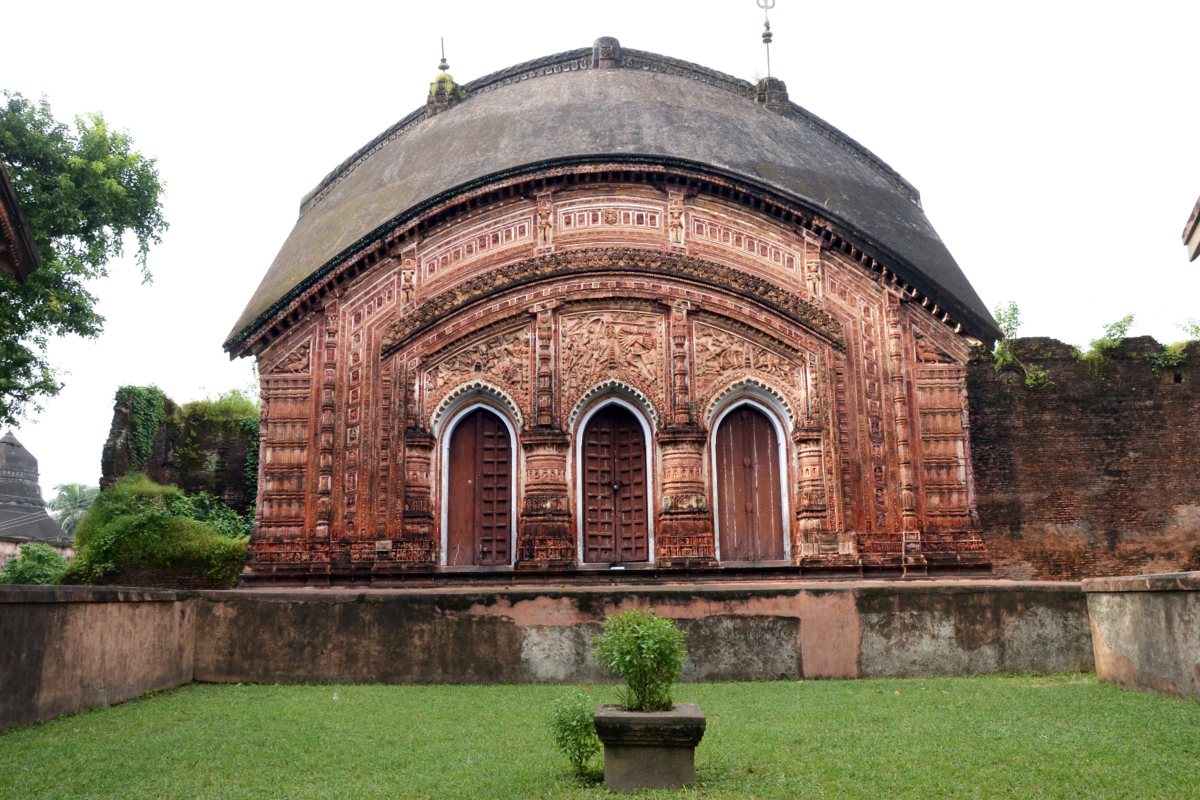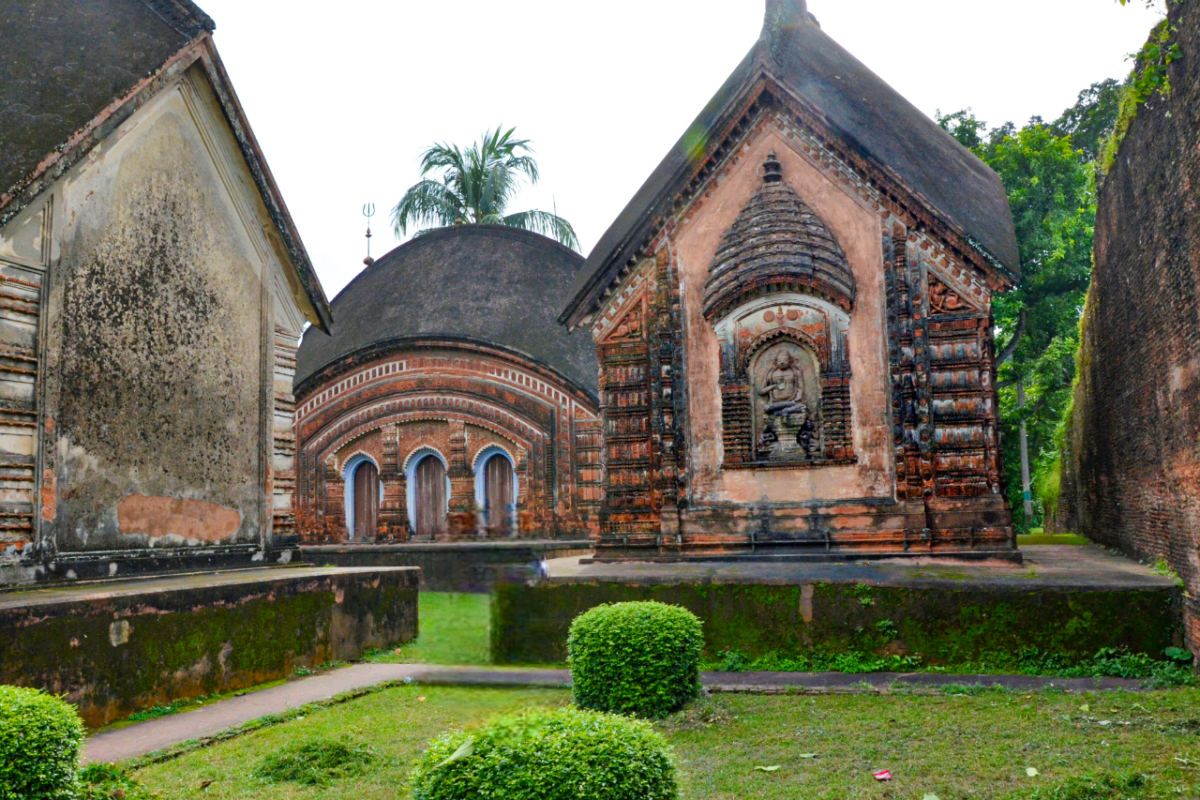Nestled along the serene banks of the Bhagirathi River in Murshidabad, Baranagar Village is a hidden gem that echoes the grandeur of Bengal’s rich cultural and spiritual legacy. Famed for its stunning 18th-century terracotta temples, this village stands as a testament to Bengal’s artistic excellence, with intricately carved facades narrating mythological tales and everyday life in exquisite detail. Once hailed as the “Varanasi of Bengal“, Baranagar was a thriving center for religious and cultural activities, spearheaded by the visionary Rani Bhabani, whose legacy continues to shape the village’s identity. Honored with the title of India’s Best Tourism Village in Agri-Tourism in 2024, Baranagar marries historical significance with sustainable rural practices, offering visitors a perfect blend of heritage, nature, and enduring artistry.
The village holds immense historical significance as a prominent center of Bengal’s religious, architectural, and cultural heritage in the 18th century, rising to prominence under the patronage of Rani Bhabani, the powerful zamindar and philanthropist revered as the “Queen of Murshidabad.” Her visionary leadership transformed the village, notably through the construction of the Char Bangla Temples, which remain remarkable examples of Bengal’s terracotta architecture.
Baranagar also became a thriving hub for Vaishnavism, drawing pilgrims and scholars from across the region. Its spiritual atmosphere, combined with its rich cultural heritage, earned it the title of the “Varanasi of Bengal.” Legend has it that Rani Bhabani envisioned constructing 108 temples along the Ganges to elevate Baranagar’s status to that of Varanasi; however, she stopped at 107 for reasons unknown.
Strategically located along the Bhagirathi River, the village prospered during the Nawab period, benefiting from its position on a vital trade route. Today, Baranagar’s temples and historical structures continue to inspire regional architecture, symbolizing the enduring legacy of Bengal’s illustrious past. This heritage village is a must-visit for world tourists interested in archaeology, art, and history.
Char Bangla Temple Complex

The Char Bangla Temples of Baranagar are a stunning collection of four terracotta temples that stand as masterpieces of 18th-century Bengal temple architecture. Built by Rani Bhabani in the village of Baranagar, these temples are dedicated to Lord Shiva and are revered for their intricate terracotta work that adorns the outer walls. Each temple is a unique representation of Bengal’s rich craftsmanship, blending religious, mythological, and everyday life scenes into its design.
Key Details:
- Architectural Layout: The four temples are arranged in a quadrangular formation, giving the complex its name, “Char Bangla” (meaning “Four Bengali-style temples”). They are small, yet highly detailed, featuring the traditional Bengal hut-style roof known as the “chala,” with curved cornices that mimic the thatched-roof look common in rural Bengal.
- Terracotta Panels: The walls of the Char Bangla Temples are adorned with exquisite terracotta panels, which depict a variety of scenes, from episodes of Hindu epics like the Ramayana and Mahabharata to daily life in rural Bengal. These panels feature deities, warriors, dancers, animals, and floral motifs, showcasing a deep connection between divine and worldly life.
- Symbolism: The temples not only honor Lord Shiva but also reflect the Vaishnavite influence prevalent during Rani Bhabani’s time, as seen in depictions of Lord Krishna and his life, highlighting the spiritual diversity of the region.
- Historical Importance: The temples are an example of the Nava-ratna style and have become iconic representations of the Bengal School of Temple Architecture, influencing many future structures across the region. Their blend of artistic finesse and religious symbolism makes them a landmark in Bengal’s architectural history.
- Cultural Legacy: Though small in size, the Char Bangla Temples are considered architectural gems, preserving the terracotta art tradition that flourished in Bengal under the patronage of rulers like Rani Bhabani. They reflect the region’s devotion to religious art and its ability to encapsulate complex stories within the framework of simple village structures.

Together, these temples represent the intersection of spirituality, art, and culture, making the Char Bangla complex one of the finest terracotta temple groups in West Bengal.
Apart from the renowned Char Bangla Temples, Baranagar is home to several other historically and architecturally significant temples, each showcasing Bengal’s rich terracotta craftsmanship and religious fervor. These temples, mostly built during the 18th century under the patronage of Rani Bhabani, contribute to Baranagar’s reputation as a prominent spiritual and cultural hub.
1. Bhavaniswar Temple
- Architecture: This is one of the most striking temples in Baranagar, dedicated to Lord Shiva. The temple follows a traditional ek-ratna (single-towered) structure, adorned with intricate terracotta panels that narrate mythological stories.
- Terracotta Art: The walls feature exquisite depictions of Hindu deities, floral motifs, and scenes from epics like the Mahabharata and Ramayana. The detailing is particularly notable for its elaborate portrayal of Shiva, Parvati, and other gods, highlighting the region’s deep religious connection.
- Spiritual Significance: The Bhavaniswar Temple is a revered site for devotees, who come to offer prayers to Lord Shiva and immerse themselves in the serene, sacred atmosphere.
2. Gangeswar Temple
- Dedication: Like many temples in Baranagar, the Gangeswar Temple is dedicated to Lord Shiva and was also constructed under Rani Bhabani’s patronage.
- Design: It features a typical Bengali chala design, with a sloping roof and terracotta embellishments that capture both religious narratives and scenes of daily rural life.
- Historical Importance: The temple, though smaller than the Char Bangla complex, is significant for its role in representing the distinct style of Bengal’s temple architecture, integrating art and spirituality in a rural setting.
3. Jod Bangla Temple
- Architecture: This temple, also known as the “Twin Temple,” is a double-structure temple built in the classic Bengal hut-style (jod means twin), with sloping roofs and terracotta panels that reflect both artistic and religious themes.
- Terracotta Panels: The walls are richly adorned with carvings of Hindu gods and goddesses, particularly scenes related to Lord Vishnu and Lord Shiva. The intricate craftsmanship captures the vibrant life of 18th-century Bengal, from festivals and agricultural activities to devotional practices.
- Religious Importance: The temple serves as a major religious site for locals and visitors, particularly during festivals like Shivratri, when devotees gather to worship and celebrate.
4. Pathuri Temple
- Structure: Another architectural gem of Baranagar, the Pathuri Temple showcases a single-towered (ratna) design, typical of 18th-century Bengal temples.
- Carvings: The terracotta work on this temple is notable for its finely detailed depictions of animal figures, floral motifs, and scenes of rural life, blending the sacred with the everyday.
- Cultural Importance: The temple, though not as large as the Char Bangla complex, holds cultural significance for the village, particularly for its representation of local life and traditions through its terracotta reliefs.
5. Krishna Gopal Temple
- Dedication: This temple is dedicated to Lord Krishna, with terracotta artwork that vividly portrays scenes from Krishna’s life, including his childhood and the Rasa Lila.
- Artistic Elements: The temple’s intricate terracotta carvings are celebrated for their depictions of Krishna and his interactions with the gopis, as well as various episodes from the Mahabharata. The detailing captures the delicate expressions of the figures, showcasing the mastery of Bengal’s artisans.
- Spiritual Role: It is a major spiritual center for Vaishnavism in the region, reflecting the deep devotion to Lord Krishna that has been a hallmark of Baranagar’s religious landscape.
These temples, along with the Char Bangla complex, form an integral part of Baranagar’s architectural and spiritual legacy, making the village a destination for those interested in Bengal’s rich terracotta heritage, religious history, and cultural traditions. Together, they highlight Baranagar’s status as a center of spirituality and artistic excellence in the 18th century, under the visionary leadership of Rani Bhabani.

